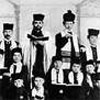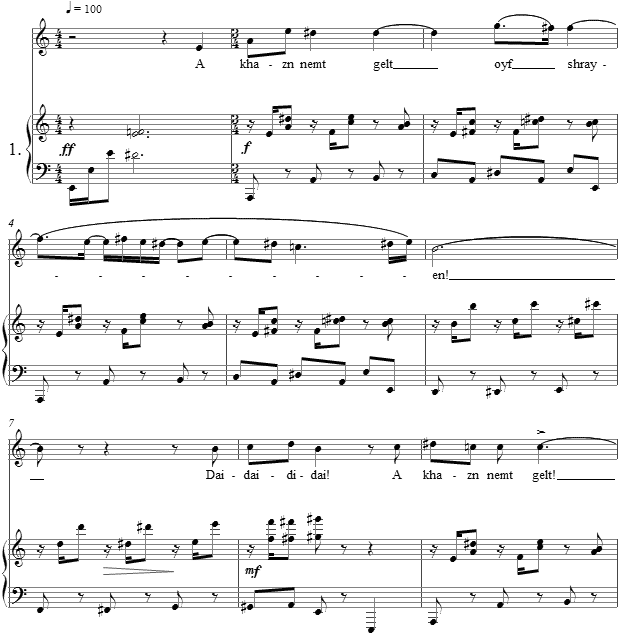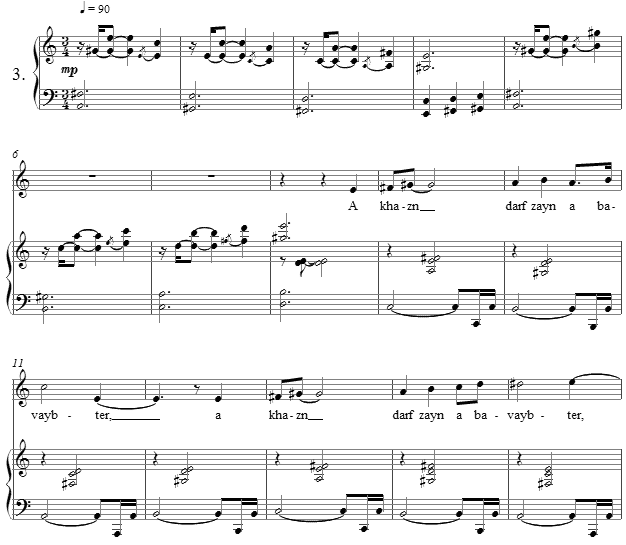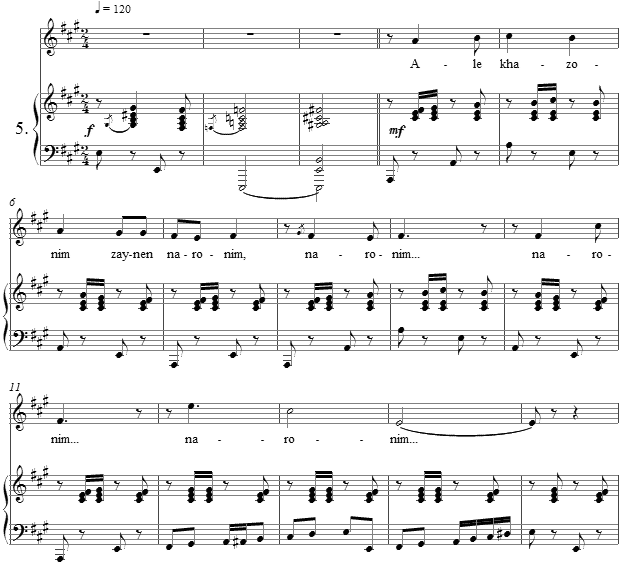Music and Texts of GARY BACHLUND
Vocal Music | Piano | Organ | Chamber Music | Orchestral | Articles and Commentary | Poems and Stories | Miscellany | FAQs
Ale khazonim - (2006)
אלע חזנים
Yiddish Folk Sayings
Five songs for high or medium voice and piano
i. A Cantor
א חזן
א
חזן נעםט געלט אווף שרייען און א רב פאר שווייגן׃A cantor takes money for screaming, and a rabbi for not screaming.
ii. Oy
װי
װי
אזוי דער חזן זאל ניט זינגעןקריגט
ער אלץ אין טאטן ארײן׃אוי
איז דאס א חזן׃ער
בעט זיך דאך בײ גאט װי בװ גזלן׃No matter how well the cantor sings, there will be criticism. Oy, is that a cantor? He pleads by God like he would plead with a criminal.
iii. With a Broken Heart
מיט א צעבראכן הארץ
א
חזן דארף זײן א באװײבטער׳ער
זאל קענען דאװענען מיט א צעבראכן הארץ׃A cantor should be married, he should be able to pray with a broken heart.
iv. All Are Experts
אלע זײנען מבין
אײנער
איז א מבין אויף א פשטל׳דער
צװײטער איז א מבין אויף חזיר האר׃אבער
אלע זײנען מבין אויף א חזן׃One is an expert with scholarship, and the second is an expert on the subject of pig bristles, but all are experts about a cantor.
v. All Cantors
אלע חזנים
אלע
חזנים זײנען נאראניםאבער
ניט יעדער נאר קאן זינגען׳רבונו־של־עולם׃
צװײ
מאל זאגט א חזן׃All cantors are fools, but not all fools can sing -- "Master of the Universe!" (Twice over, for the cantor.) [ 1 ]
The texts in the score are transliterations from the Yiddish.
[ 20 pages, circa 9' 10" ]
Cantors together in concert
A cantor (in Yiddish and Hebrew, "hazzan" sometimes transliterated "khazn" to reflect the Yiddish consonants) is a Jewish musician trained in the vocal arts who helps lead the synagogue in song-filled prayer. The verb, to "daven," has this meaning. There are many varying rules as to how a cantor should lead services, but the idea of a cantor as a paid professional does not exist in classical rabbinic sources.
The person leading the congregation in public prayers is called a "shaliach tzibbur" (Hebrew for "representative of the congregants"), and this was usually not a rabbi. In theory, any lay person can be a "shaliach tzibbur;" many synagogue attending Jews serve in this role at least once in their life. In practice, those with the best voice and the most knowledge of the prayers serve much more often. For this reason the hazzan increased in importance over the centuries. As public worship was developed in the Gaonic period, and as a general knowledge of Hebrew declined, singing gradually purely spoken elements in the services of the synagogue.
Even in the oldest times the chief qualifications demanded of the cantor, in addition to knowledge of Biblical and liturgical literature as well as the prayer "nusach" were a pleasant voice and an artistic delivery; for the sake of these, many faults were willingly overlooked. The cantor was required to possess a pleasing appearance, to be married, and to wear a beard. Sometimes, according to Isaac of Vienna (13th century), a young cantor having only a slight growth of beard was tolerated. Maimonides decided that the cantor who recited the prayers on an ordinary Sabbath and on week-days need not possess an appearance pleasing to everybody; he might even have a reputation not wholly spotless, provided he was living a life morally free from reproach at the time of his appointment.
But all these moderations of the rule disappeared on holidays; then an especially worthy cantor was demanded, one whose life was absolutely irreproachable, who was generally popular, and who was endowed with an expressive delivery. Today, a cantor, particularly in a non-Chasidic synagogue, is likely to have academic credentials, most often a bachelor's and/or a master's degree in music or in Sacred Music, sometimes a degree in Music Education or in Jewish Religious Education or a related discipline. The Doctor of Music degree is sometimes awarded to honor a cantor. In the last two centuries Jews in a number of European communities, notably Germany and England, came to view professionally trained cantors as clergy. After the enlightenment, when European nations gave full citizenship and civil rights to Jews, professionally trained cantors were accepted by the secular government as clergy in the same way that accepted rabbis as clergy. In an interesting turn of events, the United States government recognized cantors as the first Jewish clergy, even before rabbis were recognized.To illustrate the importance of cantors in synagogue worship, one finds the American Conference of Cantors representing Reform Judaism, the Cantors Assembly representing Conservative Judaism, the Orthodox movement's Cantorial Council of America. Each organization provides training and other services to the sustenance of the art of cantorial singing, or "hazzanut."
As these folk sayings suggest, some cantors have been given to displays of ego which come with the adulation of their congregations and audiences. Other cantors were perhaps less than proper in their daily lives. Sometimes therefore, sniping at the cantor was a favorite sport, and the sharp tongues of some could certainly sting. As the fourth song suggests, while no one is an expert in everything, it seems often that every one is an expert on cantors. I vouch for this observation, made over centuries but all too true today within the Jewish community.
Tessitura for high voice
These songs combine individual short Yiddish folk sayings into longer song texts. The texts in the score are notated in transliteration. [ 2 ] The original Yiddish adages may be found in the collection, Words Like Arrows, University of Toronto Press, 1984, edited by Shirley Kumove, though my less clever translations are directly from the Yiddish. A cycle on life and love is titled "Old Love," or Alte libe.
The first setting speaks of the cantor being paid for "screaming," and therefore the melismatic vocal line should be rendered with humor and faux-drama.
With so many who fancy themselves well-educated and aesthetically sensitive critics (as is true in opera and concert as well), this wonderful observation suggests that no matter how well one does, criticism however unfounded will surely follow.
The third adage suggests that the cantor be married, so as to pray with a "broken heart." One argument for married clergy -- as one finds among those who complain about the Catholic Church's rules for clerical celibacy -- is that marriage opens the individual to a greater understanding of human relationships. In this time of questions about same-sex marriage, the questions remain laughably as unresolved as ever, our modern age yielding precious little more wisdom than former ages. For this setting, gentle "broken" chords accompany the melodic recitation of the text.
The fourth text amplifies the second in complaining that "everyone" is an expert about the qualities and performance of a cantor -- whether they are qualified to judge or not. Perhaps especially "expert" when they are not qualified. The setting is a set of long-lined eight-note chords underlying this simple observation.
The last text is a bit of fun. Written in a mixed style leaning towards the music hall more than the synagogue, it is a melodious and lightly rhythmic romp as the humorous accusation flows along, that "all cantors are fools" -- perhaps as much for being easy targets of such criticism as mentioned above -- but -- the important word, "but" -- "not all fools can sing." If there is a reason to put prayer into the sounds of vocal music -- solo as well as choral -- it is to heighten the texts, repeat with musical justification so as to emphasize them even more, and make a listener's attention to and concentration on such texts more meaningful.
The score for Ale khazonim in the high key is available as a free PDF download, though any major commercial performance or recording of the work is prohibited without prior arrangement with the composer. Click on the graphic below for this piano-vocal score.
Tessitura for medium or low voice
NOTES
[ 1 ] "Twice over, for the cantor" refers to a practice of repeating texts, which is done in the context of prayer services.
Often during the High Holy Days, repetition is done to flesh out a portion of a service to allow a schedule to be observed. Twice over also sometimes indicates that the cantor would improvise on a text, repeating that which was most moving or liturgically effective "in the moment." I added this phrase from another saying, also to call attention to the repetition of the song form, as the theme returns again.
[ 2 ] Yiddish is written with Hebrew characters from right to left, while standard music notation is written from left to right. Therefore, for those whom the Yiddish characters would be too unfamiliar as for the standardization of the left to right format of musical notation, transliterations into Anglo-Germanic characters try to capture the Yiddish pronunciation -- of which there are several dialects.
In the spelling of the title to this cycle, the English word "all" has two l's as does the German on which it is based, but in Yiddish the word is spelled with one "lamed," the Hebrew character which relates to "l" in English or German. Therefore, the more adequate transliteration is "al-e." This is so throughout, such that "hazzan" is in fact rendered as "khazn," for in Yiddish the word has but three letters with the vowel interpolated after the fashion of Hebrew. The first letter, a guttural, is represented as "kh" because English has no single letter which conforms to the Yiddish or Hebrew. There is more than one fashion of transliteration, so I leave it to the performer to make the best of this.





